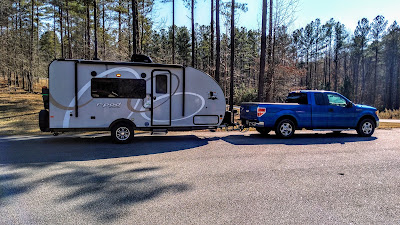AAR - After Action Review. Yesterday I served as part of a communications support team for a 5K race held at a local nature preserve. This race is an annual event that we've supported for years. We know the course setup and the checkpoint locations, and are familiar with the communications requirements. The comms team was made up of local ARES members whom I've worked with a lot in the past. Everyone was professional, knew exactly what to do, and did a great job. It's a pleasure to work with experienced communicators.
This race follows an out-and-back course, so the starting line is very close to the finish. I just grabbed a picnic table near the finish line and set up. The course is very compact, so VHF simplex using handhelds is all that's really needed.
Side note: most Amateur Radio operators underestimate the reach of VHF FM. Here in the US we indoctrinate our hams to think that VHF is only useful if it's routed through a repeater. Most new Technicians don't understand how far you can communicate using VHF simplex. Remember, the US military - Army, Navy, Marines & Air Force - have been using VHF simplex for tactical communications since World War II. They seem quite happy with its performance. My personal best is 65 miles, from Cartersville, GA to Cleveland TN, using a 30 watt mobile rig and a mag-mount antenna on the roof of my truck. I'll take that any day.
Back to the race. Like any good net control, I did a small AAR immediately after the event. I captured some general comments that applied to all operators - the need to dress warmly (it was COLD!), the need to have dual-band capability, the need to have a flashlight or head lamp, the need to wear a safety vest. Simple reminder stuff.
Personally, I learned a few lessons. Some were new, some were lessons I learned long ago but keep having to re-learn.
- have an adequate event map
- use something like a smartphone app to track both real time and race time
- conduct regular radio checks with the comms team to make sure everyone is still up and operating
- have an inclement weather (i.e., rain) plan for net control operations
- keep your eye on the race director and emergency response personnel - know where they are at all times, and make sure they understand your role
- make sure your emergency communicators are easy for event participants to identify. A small 2" x 3" callsign tag isn't enough. Be loud and proud - orange or yellow reflective safety vests for everyone
- have a computer or internet connected smartphone to maintain situational awareness for things like weather
- during times of expected bad weather (which in Georgia means any time between March - September), a NOAA weather radio programmed for SAME alerts in the area where the event is taking place, or an equivalent system
- have a back-up for everything
 |
| A net control station doesn't need to be big and fancy, it just needs to be effective |
A brief comment about assured communications. A net control's primary duty is to communicate. If you can't communicate then you are useless to the supported agency or activity. That means enough comms equipment - radios, antennas, power supplies, cables, etc. - to span the event footprint and get the job done. I had enough confidence in our ability to communicate at this race site using simple handheld radios that I didn't bother to bring out more heavy-duty gear. I just ran cross-band operations through the dual-band radio in my truck with its roof mounted antenna. However, if I was running net control operations at a site I had little familiarity with I would have deployed with a 50 watt mobile VHF rig, an external antenna, power supply (or battery), coax, etc. Supporting an event where the sponsor is counting on your ability to do your communications job is not the time or place to try to prove how well you can get things done with a 'shoestring' operation. You may be hunting squirrels but you need to show up loaded for bear, just in case.
 |
| Know who your medical support is, and where they are, at all times |
 |
| Can you spot the Amateur Radio communicator? Of course you can, and that's the point |
 |
Keeping track of both elapsed race time and real time is important. There are plenty of
clock and timer apps for smartphones you can use |
And last but not least - have fun!
W8BYH out









